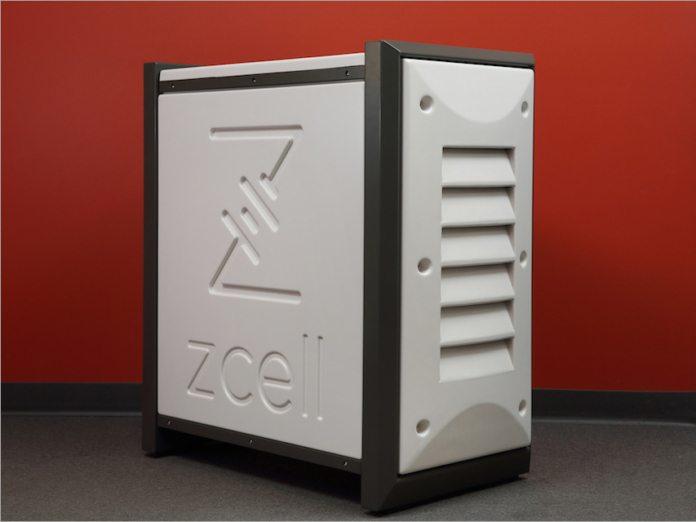
news Australian energy storage specialist Redflow is set to show its recently launched ZCell home battery and new custom-designed enclosure at the Australian Energy Storage Conference & Exhibition this week in Sydney.
ZCell is a residential energy storage system that includes a flow battery made from easily recyclable or reusable components.
A flow battery is a rechargeable system powered by two different liquids separated by a membrane across which ion exchange occurs.
Redflow’s system’s 10kWh of stored energy allows people to store daytime solar power and use it at night, or store off-peak power for peak periods.
ZCell offers a number of benefits, such as allowing 100% of energy to be discharged without battery damage, and the ability to be stored indefinitely without requiring maintenance charging.
Its creators also tout the battery’s safety features, including no risk of explosion following mechanical damage, no risk of ‘thermal runaway’ – when increased temperature leads to further increases in temperature, and an electrolyte that is fire retardant.
Further, ZCell can perform well in hot, remote locations without the need for external cooling until an ambient outside temperature of at least 45ºC.
The new outdoor-rated enclosure, measuring around 1 metre long, by 0.5m wide and 1.15m high, has been custom designed to hold Redflow’s 10 kilowatt hour (kWh) ZBM2 flow battery.
Simon Hackett, Executive Chairman at Redflow, who is to speak at an opening session of the Sydney conference, said the ZCell enclosure was designed and is being manufactured in Australia.
“This is the first time we have shown our ZCell enclosure publicly,” Hackett added.
“We’re very pleased with the design, which is both attractive and practical, that allows straightforward outdoor installation, and features a built-in secondary containment system to protect against the unlikely event of an electrolyte fluid leak,” he said.
Redflow expects to receive the first production batch of enclosures for quality assurance testing before the end of June, Hackett explained, with ZCell bundles now likely to be delivered to installers for customer deployment from August.
The firm has already installed demonstration ZCell systems at a number of Australian sites and is now developing documentation and training processes for the accreditation of qualified installation partners.
Redflow said it has received a “strong response” to the ZCell launch from prospective customers and potential installers.
“We are installing selected exemplar systems during June and July, with larger volumes of ZCell batteries scheduled to start arriving from August,” said Hackett.
ZCell’s international availability will be announced in coming months.
The Australian Energy Storage Conference & Exhibition taking place from 1-2 June at the Australian Technology Park in Sydney.
Hackett will participate in the conference’s opening panel discussion – titled “The disruption driving the New Energy Grid” – at 10am today.
Image credit: Redflow

The zCell is very impressive and I’d pick it over a lithium based solution every time, but that case looks like it was a left over from the ugly pc tower case era in the 90’s.
In a couple of years Simon should be able source a cheap supply of second hand FTTN cabinets to enclose larger installations.
Gold!!!
No these ones only have copper in them ;)
Won’t those consume electricity and require planning permission Darren? They may not store as much as the ZCell!
Nice to see where Simon is going with RedFlow, I’m thinking of picking a couple of them up once I pay my panels off.
Is there any information of the power capacity of the battery and pricing?
They are 10 kWh.
The FAQ on their sire can probablt answer most of you questions: https://faq.zcell.com/content/5/4/en-us/about-this-faq.html
The 10kWh spec is energy storage capacity and not a the power capacity, the power capacity determines how quickly the 10kWh can be delivered.
The great things about flow batteries, as I understand them, is that the energy storage capacity is purely a function of the volume of the of storage of the reagents. Bigger tank, more energy storage. The power capacity is a function of how quickly the reaction can take place across the “membrane”.
So what I was asking effectively is can it deliver 2 kW for 5 hours or is it limited to 1kW for 10 hours?
Thanks for the link, I will look at it. I think flow batteries are really exiting and have the potential (pun not intended) to really shake things up, more so than Telsa’s storage solution. Although Tesla have real cut through and the ability to grab attention.
I found the figures in the FAQ you linked, they are 3.0-3.3 kW continuous, 5.0kW peak.
The reason this is important is because if your consumption exceeds these then additional energy is imported from the grid even if the battery isn’t fully discharged.
Or you need multiple zcell systems. If you need 5-6kw constant draw you’ll need more than a 10kwh solution anyway.
Once the price comes down to a more reasonable level (eg $5k each + install etc) I’d certainly look to buy 2x zCell’s with a 5kW E/W solar system for my house. The aim would be to avoid using Peak & Shoulder power as much as possible.
I’m a lot more confident that the zCell’s will still be worth owning in 10-15 years time than a LiOn based system. On top of that I think the zCell will be much better for the environment due to the ease of recycling its fluid and components.
Yeah, same here.
Probably a lot easier/cheaper to refurb too
Apparently they can “clean” the fluid to refurbish it and reuse it.
Plus Flow batteries dont degrade over their lifespan like LiOn batteries do, they’ll provide 10kWh’s a day till they hit their design limit of 40,000kWh’s.
A 10kWh LiOn battery would be lucky to still store and export 6kWh’s after 10 years.
Comments are closed.